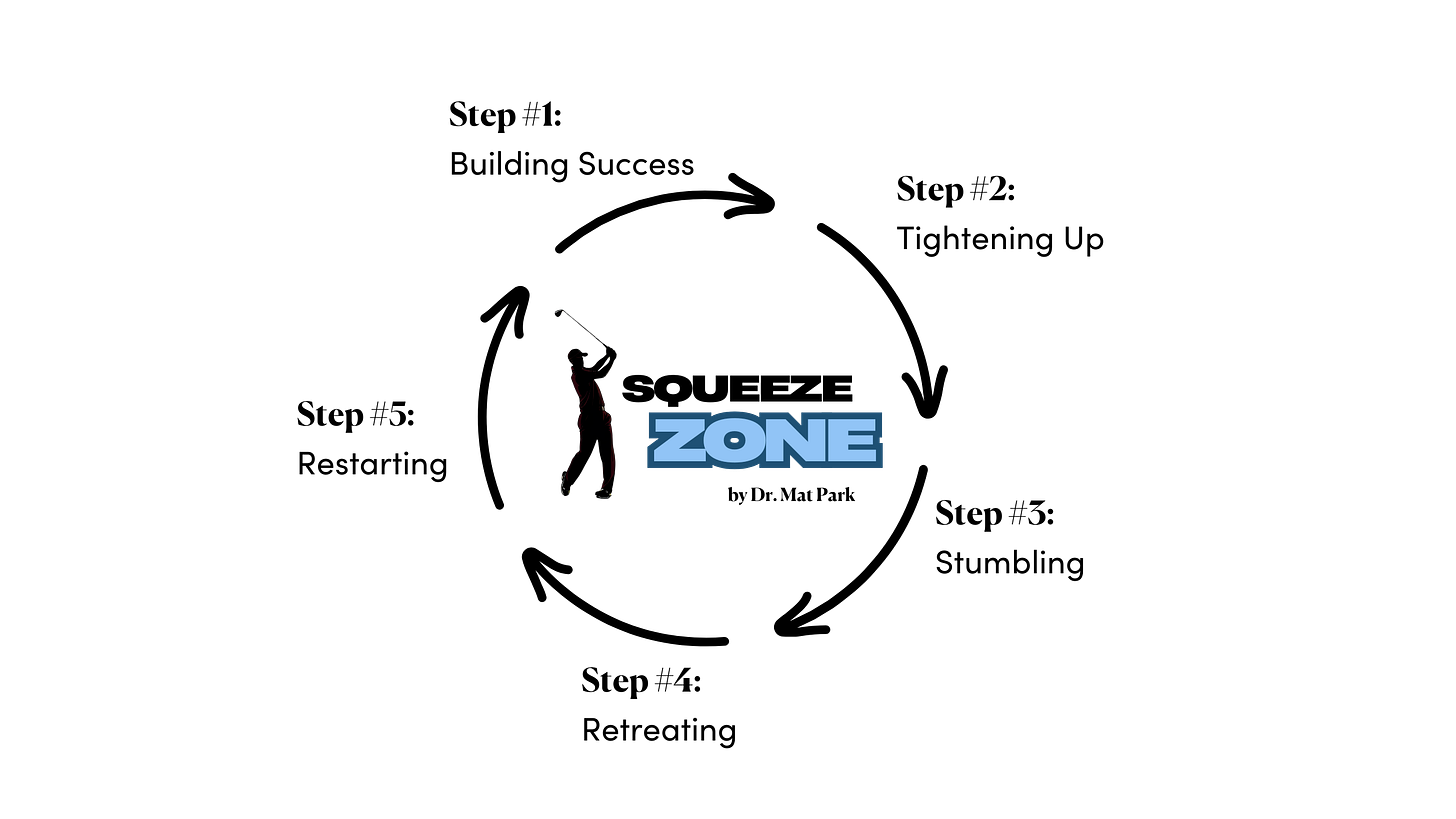The Squeeze Zone
Breaking Free from the Upper Limit Problem
Golfers know the feeling: everything is clicking, momentum is on your side, and you’re in the zone. Then, something shifts. You start thinking about how well your playing or what your score is. Suddenly, you tighten up. You start thinking too much, trying too hard not to make a mistake. What was fluid becomes rigid and tight. This is what I call, The Squeeze Zone—that critical moment where success becomes uncomfortable, and instead of riding the wave, we unconsciously sabotage ourselves.
This phenomenon, often referred to in psychology as the Upper Limit Problem, is common in golf and life. It’s what happens when we push against the edge of our comfort zone and feel the tension of success. The Squeeze Zone can hold us back, but with the right tools, we can break through it.
What Is the Squeeze Zone?
The Squeeze Zone appears when we start to experience momentum. Success feels good, but it also feels uncertain. The mind, activated by the prefrontal cortex, begins to tighten its grip, wanting to control every detail. “Don’t mess this up,” it whispers. Ironically, this heightened focus on avoiding mistakes often leads to mistakes.
When the inevitable misstep happens, it’s tempting to retreat—sometimes subconsciously—to a place that feels familiar and safe. This is our Comfort Zone (our Secure Base), where outcomes are predictable but stagnant. We may not want to be there, but it’s where our subconscious feels at home. And so, the cycle repeats: build success, tighten up, stumble, retreat, and restart.
The Upper Limit Problem: A Psychological Trap
Psychologist Gay Hendricks coined the term Upper Limit Problem to describe this self-imposed ceiling. When we approach success beyond what we believe we deserve or can handle, our minds create resistance. This resistance can manifest as self-doubt, overthinking, or even physical tension—all of which derail our performance.
For golfers, this might look like playing brilliantly through the first 12 holes, only to start second-guessing every decision on the back nine. The harder we try to hold on to success, the more it slips through our fingers.
Why Do We Retreat?
It’s all about safety. The comfort zone is predictable, even if it’s not where we want to be. Success, on the other hand, can feel unstable and risky. When we make a mistake, we feel a sense of relief—not because we wanted to fail, but because it brings us back to a space where we’re not on the edge of the unknown.
How to Abolish the Squeeze Zone
Breaking free from the Squeeze Zone requires recognizing the pattern and consciously choosing a different response. Here’s how:
Recognize the Pattern
Awareness is the first step. Notice when you start to feel the squeeze—tightening up, overthinking, or hyper-focusing on avoiding mistakes. Acknowledge it without judgment.Focus on the Process
What got you to this point of success in the first place? Chances are, it wasn’t hyper-control but rather enjoyment, trust, and a focus on the present moment. Shift your attention back to the process: one shot at a time, one breath at a time.Reframe Mistakes
Mistakes are not failures; they’re opportunities to learn and reset. Instead of spiraling, see a mistake as part of the game. Accept it, adjust, and move forward.Anchor Yourself in the Present
The Squeeze Zone thrives on fear of the future—what if I blow this? Counteract it by grounding yourself in the now. Use your senses: feel the club in your hands, hear the sound of the wind, see the target in front of you.Trust Your Tools
Remember, you have the skills and mental tools to succeed. Confidence comes from preparation, not perfection. Trust your preparation and let it guide you.
Breaking the Cycle
Golfers often ask me, “How do I stop sabotaging myself?” My answer is always the same: stop trying to control everything. Success isn’t about avoiding mistakes; it’s about responding to them with resilience and adaptability.
When you feel the Squeeze Zone creeping in, remind yourself why you love the game. Play free. Trust your instincts. Stay in the moment. By doing this, you can push past your upper limits and discover what lies beyond them.
The Squeeze Zone doesn’t have to be a trap. It can be a gateway to greater success and enjoyment—if you learn to navigate it. So next time you feel the pressure mounting, take a deep breath, let go of the outcome, and keep doing what got you there in the first place.
Stay tuned for more insights like this in my upcoming book, 18 Holes, where we’ll explore the mental game of golf and how to play better both on and off the course.
See you on the tee box…
Dr. Mat



